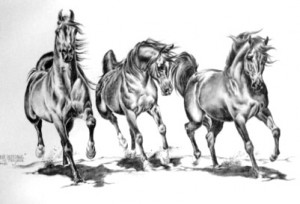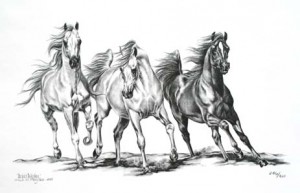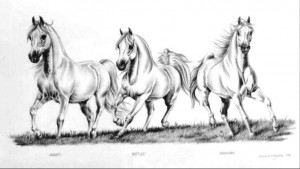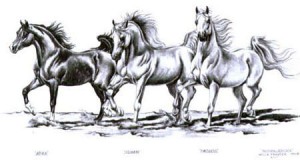Some months back I received a lovely email from Isabella Woods from the UK asking to do an article for my blog. I was thrilled to accept, so here is a general horse lovers thoughts on the Arabian breed.
ARABIANS; HORSES YOU CAN RESPECT – Words by Isabella Woods UK
Polish Heritage by Willa Frayser – Ofir, Witez II, Witraz www.willafrayserstudio.com
Even if you’re not a horsey type, you can’t help feeling some admiration for the Arabian horse. This horse has been a human companion for more than 4 millennia, as there is archaeological evidence of its ancestors going back that far. This breed of horse was a favourite of the Bedouins, who needed a horse that worked well with their nomadic lifestyle and desert climate. (Did you know that the word ‘Arab’ comes from a Semitic word meaning ‘desert’?) Arabians have also been prized by warmongers of all descriptions (from steppe raiders to the cavalry). Though we might not always approve of war, we can’t blame the Arabian for having the ideal blend of speed and sensitivity to be perfect for the job.
Desert Heritage by Willa Frayser – Nazeer, Morafic, Fahker el Din
The Mythical Arabian
Go back to ancient legends and you will see the Arabian. This breed appears in stories of the prophet Mohammed, of King Solomon, of Ishmael and more. And the Bedouin, the Arabians’ oldest companions (you can just imagine a Bedouin noble on a reclining loveseat, horse by his side), suggest that the horse was created from the four winds, gaining one of its most prized qualities (spirit, strength, speed and intelligence) from each of the compass points. Whatever the truth, Arabians have been bred since several centuries before the birth of Christ. (Some talk of proto-Arabians from 500BC, while others talk of the Muslim conquest which took the Arabian across the world from 622BC onwards.)
How to Spot an Arabian
If you’re looking for the perfect Arabian, it’s a good idea to become familiar with the main characteristics of the breed. In contrast to other horse breeds, Arabians have wedge-shaped heads with small muzzles. Their forehead, eyes and nostrils are all large. They also have a distinctive bulge between their eyes. It is thought that this feature, which allows for larger sinuses, was useful in the dry air of their desert homelands. Arabians also have long hindquarters (often well-muscled) and high tails. In terms of skeletal structure, there are sometimes differences in the number of ribs and lumbar vertebrae, but this doesn’t detract from the breed’s essential stamina and bone strength. Arabians usually range from 14.1-15.1 hands, but even the shortest of them are considered horses rather than ponies.
Crabbet Hertage by Willa Frayser – Azraff, Raffles, Skowronek
Colors and Features
Arabians are available in many coat colours, though the ArabianHorse Association recognizes bay, gray, chestnut, black and roan as purebred.Skin is always black, though some may have white markings. Other Arabian colourings include Sabino (evidenced by white markings over the knees), Rabicano (similar to roan) and grey and white. Arabians in other colours are likely to be cross bred. Purebred Arabians today haven’t changed much from those ridden by the ancient Bedouins, as they focused on keeping the breed pure. In fact, most Bedouins could tell you as much about their horses as about their children. This has resulted in the distinctive characteristics which we admire today.
One of the best features of the Arabians is their excellent temperament, which no doubt comes from having lived side by side with humans for so many centuries. Over the course of time, their good disposition has been improved by breeding. At the same time, they are also spirited, intelligent horses, quick to learn new things, whether good or bad. This is one reason why correct training and handling is particularly important with Arabians.
Russian Heritage by Willa Frayser
Arabians in Australia
Arabians initially arrived in Australia via England and one of the most famous studs which sold foundation Arabian horses to Australia was the Crabbet Arabian Stud. This stud also eventually exported horses to a number of countries around the world.
Today, Arabians are found all over the world and have made a name for themselves in equestrian competitions and endurance riding. Today’s riders follow in the footsteps of Genghis Khan, Alexander the Great and George Washington when they ride Arabians. These horses remain an ultra-popular breed, because now, as then, Arabians are horses you can truly respect.




2 Responses
Willa Frayser
WOW, What a wonderful article Carmel! I haven’t seen my artwork used like that ever before – it really makes the reason I created them even more important, besides paying tribute to such wonderful reference Stallions! Thank YOU!
Ho Rse Arlem
Wow! Excellent. When I’m reading the whole content I feel so smart. Very informative article that helps me a lot. I will share this to my friends and classmates. Wait. Just sharing this website (www.horses-haarlem-oil.com), I read also about the benefits of their products. By the way, I am so happy to read your content here. I will share this link/website of you to my fellows. Thank you and God bless! Have a great day, ahead!